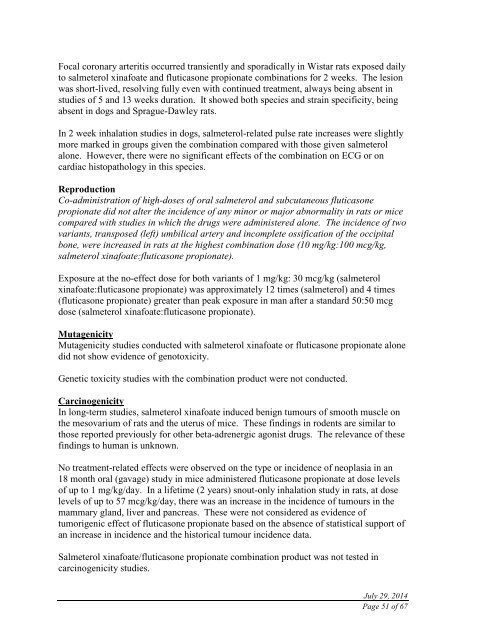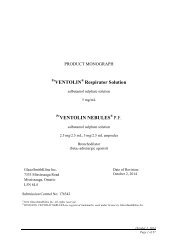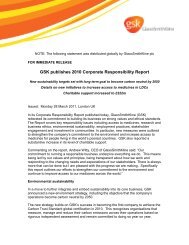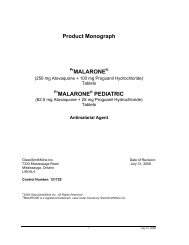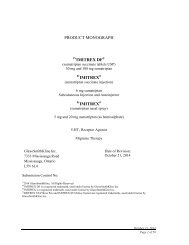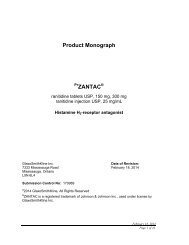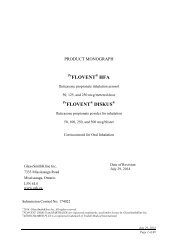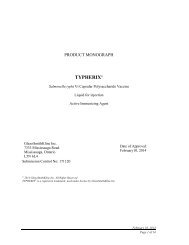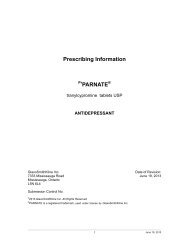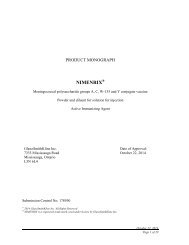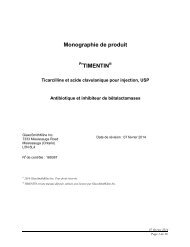ADVAIR DISKUS ADVAIR - GlaxoSmithKline
ADVAIR DISKUS ADVAIR - GlaxoSmithKline
ADVAIR DISKUS ADVAIR - GlaxoSmithKline
You also want an ePaper? Increase the reach of your titles
YUMPU automatically turns print PDFs into web optimized ePapers that Google loves.
Focal coronary arteritis occurred transiently and sporadically in Wistar rats exposed daily<br />
to salmeterol xinafoate and fluticasone propionate combinations for 2 weeks. The lesion<br />
was short-lived, resolving fully even with continued treatment, always being absent in<br />
studies of 5 and 13 weeks duration. It showed both species and strain specificity, being<br />
absent in dogs and Sprague-Dawley rats.<br />
In 2 week inhalation studies in dogs, salmeterol-related pulse rate increases were slightly<br />
more marked in groups given the combination compared with those given salmeterol<br />
alone. However, there were no significant effects of the combination on ECG or on<br />
cardiac histopathology in this species.<br />
Reproduction<br />
Co-administration of high-doses of oral salmeterol and subcutaneous fluticasone<br />
propionate did not alter the incidence of any minor or major abnormality in rats or mice<br />
compared with studies in which the drugs were administered alone. The incidence of two<br />
variants, transposed (left) umbilical artery and incomplete ossification of the occipital<br />
bone, were increased in rats at the highest combination dose (10 mg/kg:100 mcg/kg,<br />
salmeterol xinafoate:fluticasone propionate).<br />
Exposure at the no-effect dose for both variants of 1 mg/kg: 30 mcg/kg (salmeterol<br />
xinafoate:fluticasone propionate) was approximately 12 times (salmeterol) and 4 times<br />
(fluticasone propionate) greater than peak exposure in man after a standard 50:50 mcg<br />
dose (salmeterol xinafoate:fluticasone propionate).<br />
Mutagenicity<br />
Mutagenicity studies conducted with salmeterol xinafoate or fluticasone propionate alone<br />
did not show evidence of genotoxicity.<br />
Genetic toxicity studies with the combination product were not conducted.<br />
Carcinogenicity<br />
In long-term studies, salmeterol xinafoate induced benign tumours of smooth muscle on<br />
the mesovarium of rats and the uterus of mice. These findings in rodents are similar to<br />
those reported previously for other beta-adrenergic agonist drugs. The relevance of these<br />
findings to human is unknown.<br />
No treatment-related effects were observed on the type or incidence of neoplasia in an<br />
18 month oral (gavage) study in mice administered fluticasone propionate at dose levels<br />
of up to 1 mg/kg/day. In a lifetime (2 years) snout-only inhalation study in rats, at dose<br />
levels of up to 57 mcg/kg/day, there was an increase in the incidence of tumours in the<br />
mammary gland, liver and pancreas. These were not considered as evidence of<br />
tumorigenic effect of fluticasone propionate based on the absence of statistical support of<br />
an increase in incidence and the historical tumour incidence data.<br />
Salmeterol xinafoate/fluticasone propionate combination product was not tested in<br />
carcinogenicity studies.<br />
July 29, 2014<br />
Page 51 of 67


